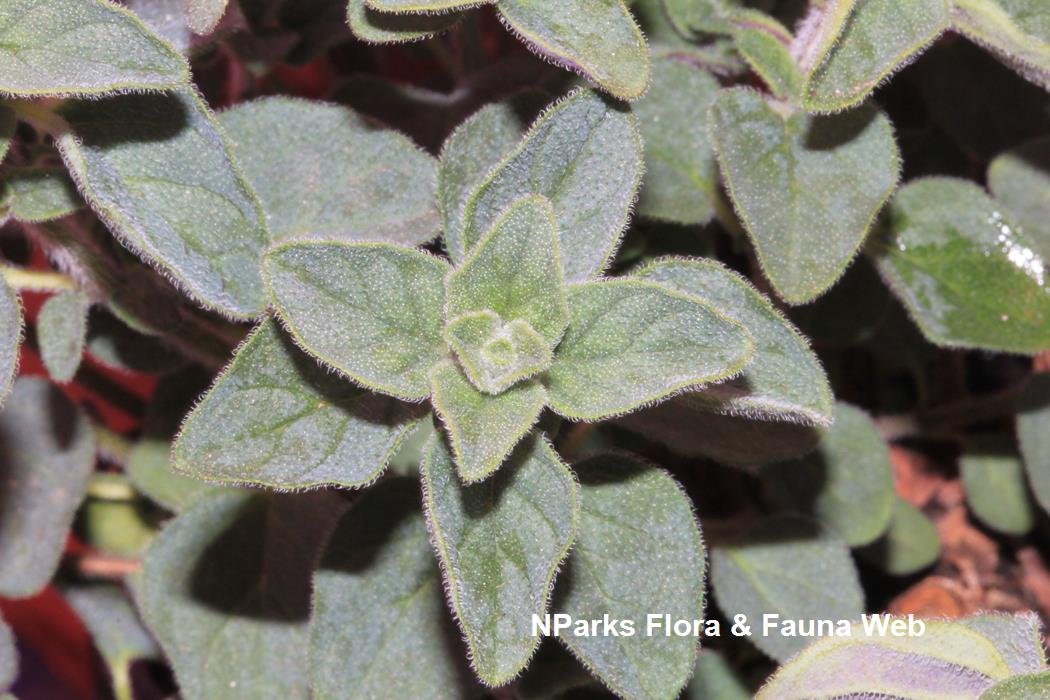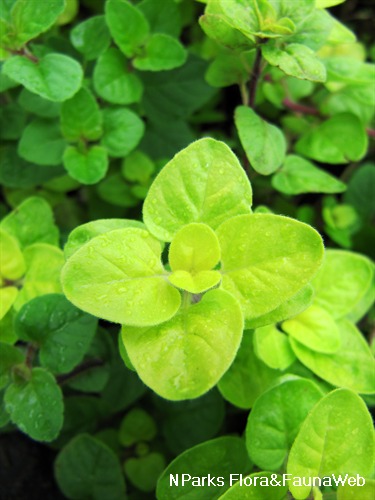
Name
Classifications and Characteristics
| Plant Division | Angiosperms (Flowering Seed Plants) (Dicotyledon) |
|---|---|
| Plant Growth Form | Herbaceous Plant |
| Lifespan (in Singapore) | Perennial |
| Mode of Nutrition | Autotrophic |
| Maximum Height | 0.3 m to 0.6 m |
| Maximum Plant Spread / Crown Width | 0.3 m to 0.6 m |
Biogeography
| Native Distribution | Northern Africa to Turkey |
|---|---|
| Native Habitat | Terrestrial |
| Preferred Climate Zone | Mediterranean |
| Local Conservation Status | Non-native (Horticultural / Cultivated Only) |
Description and Ethnobotany
| Growth Form | Erect perennial herb up to 0.6 m tall. |
|---|---|
| Foliage | Egg-shaped leaves occur in pairs along the stem. |
| Flowers | The inflorescence is composed of a stack of hairy, egg-shaped bracts with small, tubular flowers inserted between the tightly packed bracts. |
| Fruit | The dry, indehiscent fruit is known as a nutlet. |
| Habitat | It naturally occurs in rocky areas and slopes up to 1500 m above sea level. |
| Cultivation | Origanum majorana grows best in well-drained, sandy soil which is kept on the drier side. Leaves are most flavourful before flowering. Pinch the stem tips to encourage branching. |
| Ethnobotanical Uses | Edible Plant Parts : Edible Leaves Food (Herb or Spice): This herb is commonly used in Mediterranean and western European cuisine. Medicinal: Sweet Marjoram is used in traditional medicine to help regulate the menstrual cycle. A study by Haj-Husein et al. (2016) concluded that marjoram tea reduced adrenal androgens and increased insulin sensitivity in women with polycystic ovary syndrome. According to Ayurveda (an Indian system of traditional medicine), Sweet Marjoram can be used to treat indigestion and flatulence. |
Landscaping Features
| Desirable Plant Features | Fragrant (Foliage) |
|---|
Fauna, Pollination and Dispersal
| Pollination Method(s) | Biotic (Fauna) |
|---|
Plant Care and Propagation
| Light Preference | Full Sun, Semi-Shade |
|---|---|
| Water Preference | Moderate Water, Little Water |
| Rootzone Tolerance | Drought Tolerant, Well-Drained Soils, Alkaline high pH Soils |
| Propagation Method | Seed |
Foliar
| Foliage Retention | Evergreen |
|---|---|
| Mature Foliage Colour(s) | Green, Silver / Grey |
| Mature Foliage Texture(s) | Velvety / Furry / Tomentose |
| Prominent Young Flush Colour(s) | Silver / Grey |
| Young Flush Texture(s) | Velvety / Furry / Tomentose |
| Foliar Type | Simple / Unifoliate |
| Foliar Arrangement Along Stem | Opposite |
| Foliar Attachment to Stem | Petiolate |
| Foliar Shape(s) | Non-Palm Foliage (Ovate, Elliptical) |
| Foliar Venation | Pinnate / Net |
| Foliar Margin | Entire |
| Foliar Apex - Tip | Acute |
| Foliar Base | Attenuate |
Floral (Angiosperm)
| Flower & Plant Sexuality | Bisexual Flowers |
| Flower Colour(s) | Blue, Pink, Purple, White |
|---|---|
| Flower Grouping | Cluster / Inflorescence |
| Flower Location | Terminal |
| Flower Symmetry | Bilateral |
| Individual Flower Shape | Labiate / Lipped |
| Inflorescence Type | Raceme |
Fruit, Seed and Spore
| Fruit Classification | Simple Fruit |
|---|---|
| Fruit Type | Indehiscent Dry Fruit |
Image Repository
Others
| Master ID | 33590 |
|---|---|
| Species ID | 8004 |
| Flora Disclaimer | The information in this website has been compiled from reliable sources, such as reference works on medicinal plants. It is not a substitute for medical advice or treatment and NParks does not purport to provide any medical advice. Readers should always consult his/her physician before using or consuming a plant for medicinal purposes. |





